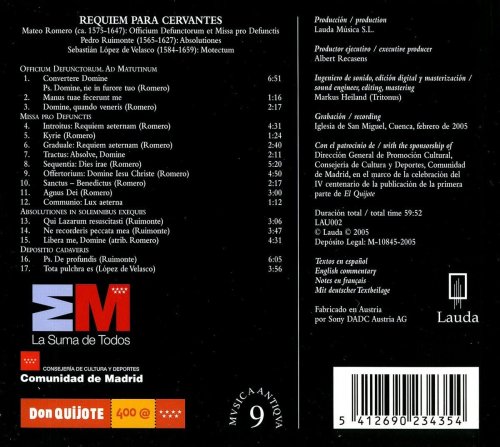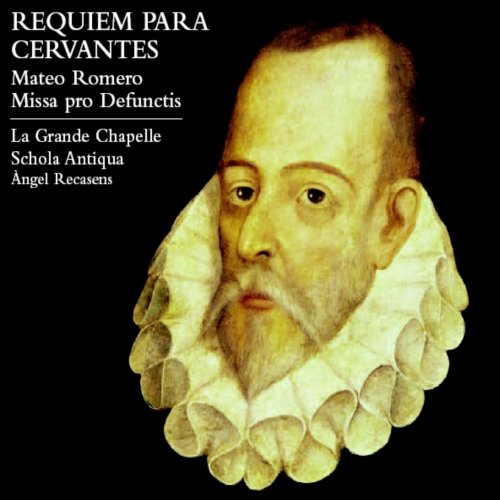
Angel Recasens, La Grande Chapelle - Mateo Romero: Missa Pro Defunctis (2005)
BAND/ARTIST: Angel Recasens, La Grande Chapelle
- Title: Mateo Romero: Missa Pro Defunctis
- Year Of Release: 2005
- Label: Lauda Música
- Genre: Classical
- Quality: flac lossless (tracks) +Booklet
- Total Time: 00:59:52
- Total Size: 269 mb
- WebSite: Album Preview
Tracklist
01. Mateo Romero: Officium defunctorum ad matutinum-Convertere domine, Domine ne in furore tuo
02. Mateo Romero: Officium defunctorum ad matutinum-Manus tuae fecerunt me
03. Mateo Romero: Officium defunctorum ad matutinum-Domine, quando veneris
04. Mateo Romero: Misa pro defunctis-Introitus, Requiem aeternam
05. Mateo Romero: Misa pro defunctis-Kyrie
06. Mateo Romero: Misa pro defunctis-Graduale: Requiem aeternam. In memoria aeterna
07. Mateo Romero: Misa pro defunctis-Tractus, Absolve Domine
08. Mateo Romero: Misa pro defunctis-Sequentia, Dies irae
09. Mateo Romero: Misa pro defunctis-Offertorium, Domine Iesu Christe. Hostias et preces
10. Mateo Romero: Misa pro defunctis-Sanctus, Benedictus
11. Mateo Romero: Misa pro defunctis-Agnus Dei
12. Mateo Romero: Misa pro defunctis-Communio, Lux aeterna
13. Pedro Ruimonte: Absolutiones in solemnibus exequis-Qui Lazarum resuscitasti
14. Pedro Ruimonte: Absolutiones in solemnibus exequis-Ne recorderis peccata mea
15. Mateo Romero: Absolutiones in solemnibus exequis-Libera me Domine
16. Pedro Ruimonte: Deposito cadaveris-De profundis clamavi ad te
17. Sebastián López de Velasco: Deposito cadaveris-Tota pulchra es amica mea

The commemoration of the fourth centenary of the publication of Don Quixote in 2005 was the best occasion to pay homage, not only to the great genius of Spanish literature, Miguel de Cervantes, but to other leading artistic and cultural figures of the Golden Age. Mateo Romero (ca. 1575-1647), music master of the Chapel Royal from 1598 to 1633 (during the reigns of Philip III and Philip IV) was the most important composer at the Spanish court around 1616, the year of Cervantes’s death.
The rediscovery of his eight-part Missa pro Defunctis is doubly interesting. Firstly, because it constitutes the first recording of one of the most popular works at the beginning of the seventeenth century. And secondly, it reclaims one of the greatest composers of the Spanish Baroque.
The so-called “Maestro Capitán” excelled at polyphonic writing for two choirs (stile moderno), which was very fashionable at the main musical centres in Europe and especially at St Mark’s Basilica in Venice. The Requiem for two choirs is one of Romero’s best works. It is very solid and the vocal writing is impeccable.
With the collaboration of the musicologist and performer Juan Carlos Asensio, the program reconstructs a Mass for the Dead from the period, with the characteristic alternation of polyphonic works and plainchant, the latter taken from the El Escorial chant books from the beginning of the seventeenth century. Matins responsories from the Office for the Dead complete the program, which were sung during absolutions at the time, and the magnificent psalm De profundis, which the priests recited or intoned while the procession to the depositio or tomb of the deceased took place. Some of these responsories were composed by another of Cervantes’s contemporaries, the Zaragozan Pedro Ruimonte (1565-1627), who was none other than chapel master to the Governor of the Low Countries, the Archduke Albert. His mournful works (in the Missae sex) were published in Antwerp in 1614.
This recording of the “Requiem for Cervantes” is, thus, of prime importance in that it rediscovers some of the most outstanding works composed in Spain at the beginning of the seventeenth century and sets them in their original liturgical context.
01. Mateo Romero: Officium defunctorum ad matutinum-Convertere domine, Domine ne in furore tuo
02. Mateo Romero: Officium defunctorum ad matutinum-Manus tuae fecerunt me
03. Mateo Romero: Officium defunctorum ad matutinum-Domine, quando veneris
04. Mateo Romero: Misa pro defunctis-Introitus, Requiem aeternam
05. Mateo Romero: Misa pro defunctis-Kyrie
06. Mateo Romero: Misa pro defunctis-Graduale: Requiem aeternam. In memoria aeterna
07. Mateo Romero: Misa pro defunctis-Tractus, Absolve Domine
08. Mateo Romero: Misa pro defunctis-Sequentia, Dies irae
09. Mateo Romero: Misa pro defunctis-Offertorium, Domine Iesu Christe. Hostias et preces
10. Mateo Romero: Misa pro defunctis-Sanctus, Benedictus
11. Mateo Romero: Misa pro defunctis-Agnus Dei
12. Mateo Romero: Misa pro defunctis-Communio, Lux aeterna
13. Pedro Ruimonte: Absolutiones in solemnibus exequis-Qui Lazarum resuscitasti
14. Pedro Ruimonte: Absolutiones in solemnibus exequis-Ne recorderis peccata mea
15. Mateo Romero: Absolutiones in solemnibus exequis-Libera me Domine
16. Pedro Ruimonte: Deposito cadaveris-De profundis clamavi ad te
17. Sebastián López de Velasco: Deposito cadaveris-Tota pulchra es amica mea

The commemoration of the fourth centenary of the publication of Don Quixote in 2005 was the best occasion to pay homage, not only to the great genius of Spanish literature, Miguel de Cervantes, but to other leading artistic and cultural figures of the Golden Age. Mateo Romero (ca. 1575-1647), music master of the Chapel Royal from 1598 to 1633 (during the reigns of Philip III and Philip IV) was the most important composer at the Spanish court around 1616, the year of Cervantes’s death.
The rediscovery of his eight-part Missa pro Defunctis is doubly interesting. Firstly, because it constitutes the first recording of one of the most popular works at the beginning of the seventeenth century. And secondly, it reclaims one of the greatest composers of the Spanish Baroque.
The so-called “Maestro Capitán” excelled at polyphonic writing for two choirs (stile moderno), which was very fashionable at the main musical centres in Europe and especially at St Mark’s Basilica in Venice. The Requiem for two choirs is one of Romero’s best works. It is very solid and the vocal writing is impeccable.
With the collaboration of the musicologist and performer Juan Carlos Asensio, the program reconstructs a Mass for the Dead from the period, with the characteristic alternation of polyphonic works and plainchant, the latter taken from the El Escorial chant books from the beginning of the seventeenth century. Matins responsories from the Office for the Dead complete the program, which were sung during absolutions at the time, and the magnificent psalm De profundis, which the priests recited or intoned while the procession to the depositio or tomb of the deceased took place. Some of these responsories were composed by another of Cervantes’s contemporaries, the Zaragozan Pedro Ruimonte (1565-1627), who was none other than chapel master to the Governor of the Low Countries, the Archduke Albert. His mournful works (in the Missae sex) were published in Antwerp in 1614.
This recording of the “Requiem for Cervantes” is, thus, of prime importance in that it rediscovers some of the most outstanding works composed in Spain at the beginning of the seventeenth century and sets them in their original liturgical context.
As a ISRA.CLOUD's PREMIUM member you will have the following benefits:
- Unlimited high speed downloads
- Download directly without waiting time
- Unlimited parallel downloads
- Support for download accelerators
- No advertising
- Resume broken downloads


